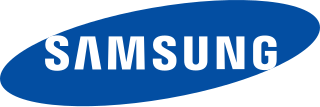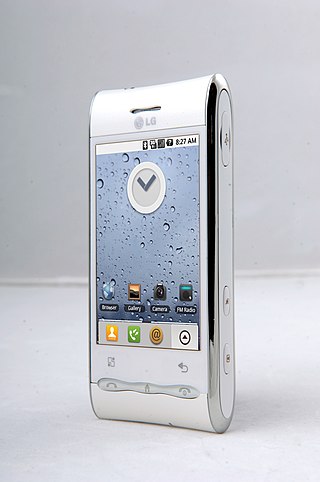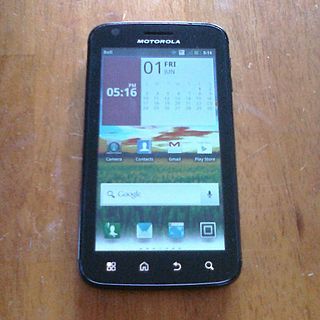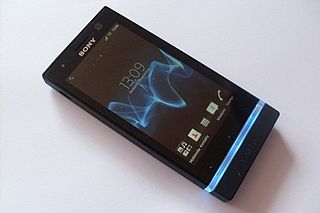
The Samsung Wave S8500 is a smartphone developed and produced by Samsung Electronics. It is the first smartphone to run the Bada operating system developed by Samsung Electronics, which was commercially released on May 24, 2010. The Wave is a touchscreen phone powered by Samsung's "Hummingbird" CPU (S5PC110), which includes 1 GHz ARM Cortex-A8 CPU and a built-in PowerVR SGX 540 graphics engine. It also has a "Super AMOLED" screen and 720p high-definition video capture capabilities. Due to shortage of Super AMOLED screens, Samsung released a successor to the device called Wave II and ceased production of the original S8500 model.

The Droid X is a smartphone released by Motorola on July 2010. The smartphone was renamed Motoroi X for its release in Mexico on November 9, 2013. The Droid X runs on the Android operating system, and the latest version supported was 2.3 Gingerbread. It was distributed by Verizon Wireless in the United States and Iusacell in Mexico.

The LG Optimus, also known as the LG Optimus GT540, LG GT540 Swift and the LG Loop GT540, is a mid-level Android smartphone designed and manufactured by LG Electronics. Released running Android 1.6 Donut, the device can be officially upgraded to Android 2.1 Eclair via an LG software release.

The Motorola Atrix 4G is an Android-based smartphone developed by Motorola, introduced at CES 2011 along with the Motorola Xoom, Motorola Droid Bionic, and Motorola Cliq 2 on January 5, 2011. It was made available in the first quarter of 2011.

The Sony Ericsson Xperia pro is an Android smartphone from Sony Ericsson which was launched in October 2011. The Xperia Pro has a 3.7-inch (94 mm) capacitive touch-screen, slider keyboard, smart phone with mobile BRAVIA engine which optimises the picture and runs at a resolution of 854×480 pixels, a 1 GHz Snapdragon processor, an 8.1 mega-pixel camera, a dedicated Two-step camera key, USB host port, HDMI-out, 512 MB of onboard RAM, and an 8 GB microSD card. The Sony Ericsson Xperia Pro is available in black, silver, or red.

The LG Optimus 3D is a 3D-enabled Android 2.2 Froyo 3D mobile device released on 7 July 2011 in the UK and advertised as the world's first full 3D mobile phone. It has 512 MB of RAM and 8 GB of onboard storage, which can be expanded by up to 32 GB using a micro SDHC card. The phone features two 5 MP back-facing cameras that are capable of filming 720p 3D and Full HD 1080p in 2D, while pictures taken in 2D mode are 5 MP and 3 MP when taking a 3D picture. It also includes a VGA front-facing camera for video-calling. The phone features a 3D user interface which allows the users to access 3D content, such as YouTube in 3D, 3D games and apps, or 3D gallery with a push of a button.

The Acer Iconia is a range of tablet computers from Acer Inc. of Taiwan.

The Samsung Captivate Glide (SGH-i927) as it is called in the United States, and sold as the Samsung Galaxy S Glide (SGH-i927R) in Canada, is the first physical QWERTY Galaxy S class smartphone running under the Android operating system to be released by Samsung for AT&T (US) and Rogers Wireless (Canada).

The Sony Ericsson Xperia mini is an Android smartphone from Sony Ericsson, released in August 2011. The Xperia mini has a "mobile BRAVIA engine" driving a 320×480 pixels 3-inch (76 mm) capacitive touch-screen, a 1 GHz Snapdragon S2 processor, a 5 megapixel camera, 512 MB of onboard RAM, and comes stock with a 2 GB microSD card. The phone is one of Sony Ericsson's environmentally friendly "Greenheart" range, featuring devices made of recycled materials, longer battery life and low-energy chargers, as well as minimal use of paper through reduced packaging and the replacement of the traditional printed user manual with one stored on the phone.

The Sony Ericsson Xperia ray (ST18i) is an Android smartphone from Sony Ericsson. It was unveiled on 22 June 2011 in Singapore during CommunicAsia 2011. It was announced that the Xperia ray would be released globally in select countries from Q3 2011.

The Sony Xperia S is an Android smartphone from Sony launched at the 2012 Consumer Electronics Show. It was first released in February 2012 as the Sony Ericsson Xperia NX in Japan, while the Sony Xperia S was released in March 2012 as a restyled version of the Sony Ericsson Xperia NX in more than 160 countries. It is the first Sony-only branded smartphone after Sony acquired Ericsson's stake in Sony Ericsson in January 2012. The Xperia S has a 4.3 in (110 mm) touch-screen with the mobile BRAVIA engine which optimizes the picture, a 1.5 GHz dual core processor, a 12.0-megapixel rear camera, HDMI-out, 1 GB of RAM, and 32 GB of internal storage.

The Sony Xperia U ST25i, codenamed Kumquat during its development, is an Android smartphone from Sony. It was launched at the 2012 Mobile World Congress held in Barcelona, and is the second Sony-only branded smartphone after Sony acquired Ericsson's stake in Sony Ericsson in January 2012. The Xperia U has a 3.5-inch (88.9 mm) touch-screen with the mobile BRAVIA engine which optimises the picture, a 1 GHz dual core processor, a 5 mega-pixel rear camera, 0.3 mega-pixel front camera, 512 MB of RAM, and 8 GB of internal storage. The cap at the bottom of the phone is interchangeable. The phone is shipped with four caps: pink, white, yellow and black.

The LG Optimus 4X HD is a slate, multi-touch smartphone running the Android operating system. Designed and manufactured by LG Electronics. The Optimus 4X HD was the world's first smartphone announced with a quad-core processor along with the HTC One X and the Samsung Galaxy S3 and the fourth phone in the LG Optimus-Android series. LG first introduced the LG Optimus 4X HD at Mobile World Congress. The Optimus 4X HD was launched with Android 4.0 Ice Cream Sandwich. Since April 2013, some variants have had a Jellybean update available.

Sony Ericsson Xperia Neo V is an Android smartphone by Sony Ericsson that supersedes the Sony Ericsson Xperia Neo. It was launched in October 2011 as a cheaper albeit alternative variant of the more expensive Sony Ericsson Xperia Neo. Sony scaled down the camera from 8.1 MP to 5.0 MP in the case of the Neo V so as to keep production costs down.

LG Optimus L5 is a slate smartphone designed and manufactured by LG Electronics. Optimus L5 is the mid-range handset in the L series, and it makes the transition to Android 4.0.

Sony Xperia T is an Android smartphone manufactured by Sony Mobile. Introduced on 29 August 2012, it is Sony Mobile's last device ever introduced to feature the Sony Ericsson liquid energy logo after Sony acquired Ericsson's stake in Sony Ericsson in January 2012. It was released in October 2012.

The LG Optimus G is a smartphone designed and manufactured by LG Electronics. It was announced on September 19, 2012; On January 18, 2013, LG announced that the device reached 1 million in sales four months after its release in Korea, Japan, Canada, and the U.S. The LG Optimus G is also closely related to the Nexus 4 with similar specifications and a similar design.

The LG Optimus Vu was Android smartphone/tablet computer hybrid ("phablet"), released in August 2012 and noted for its 4:3 aspect ratio 5.0-inch screen size—between that of conventional smartphones, and larger tablets. It is powered by a 1.5 GHz quad-core Nvidia Tegra 3 CPU with Nvidia ULP GeForce GPU. The Korean version of the phone, known as LG Optimus Vu F100S was released in March, 2012, with a dual-core 1.5 GHz Qualcomm MSM 8660 Snapdragon CPU and Adreno 220 GPU, and with Android 2.3.5 Gingerbread. The Korean model has since received updates to Android 4.0.4 Ice Cream Sandwich and Android 4.1.2 Jelly Bean.

The LG Optimus Vu II is an Android smartphone/tablet computer hybrid ("phablet"), released in September 2012 and noted for its 5.0-inch screen size—between that of conventional smartphones, and larger tablets. It is powered by a 1.5 GHz dual-core Krait CPU with Adreno 225 GPU and runs on Android 4.0.4 Ice Cream Sandwich which is upgradable to Android 4.4.2 KitKat
The Samsung Galaxy Pocket Plus is an Android smartphone manufactured by Samsung that was released in January 2012 as the successor to the original Samsung Galaxy Pocket. The handset is still budget-oriented, with a relatively small 2.8-inch LCD. Its specifications are similar to that of the original Samsung Galaxy Pocket, with only minor upgrades such as the OS which is Android 4.0 ICS and the internal storage. The Pocket Plus is powered by an 850 MHz processor and offers connectivity options including 3G, Wi-Fi and Bluetooth 4.0. Internally, it comes with an upgraded 4 GB of storage which can be further expanded to up to 32 GB using a microSD card, and with 1200 mAh Li-ion battery.


















